Pressure Measurement By Manometer
The relationship between pressure and head is used to measure pressure with a manometer (also know as a liquid gauge).
Objective:
- To demonstrate the analysis and use of various types of manometers for pressure measurement.
1. The Piezometer Tube Manometer
The simplest manometer is a tube, open at the top, which is attached to the top of a vessel containing liquid at a pressure (higher than atmospheric) to be measured. An example can be seen in the figure below. This simple device is known as a Piezometer tube. As the tube is open to the atmosphere the pressure measured is relative to atmospheric so is gauge pressure.
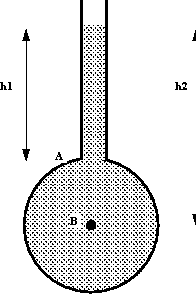
A simple piezometer tube manometer

This method can only be used for liquids (i.e. not for gases) and only when the liquid height is convenient to measure. It must not be too small or too large and pressure changes must be detectable.
2. The "U"-Tube Manometer
Using a "U"-Tube enables the pressure of both liquids and gases to be measured with the same instrument. The "U" is connected as in the figure below and filled with a fluid called the manometric fluid. The fluid whose pressure is being measured should have a mass density less than that of the manometric fluid and the two fluids should not be able to mix readily - that is, they must be immiscible.
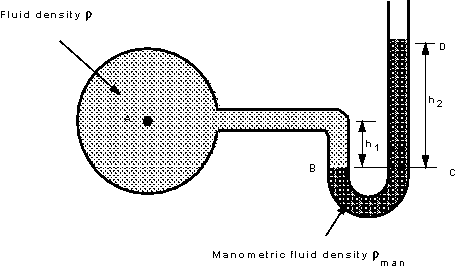
A "U"-Tube manometer
Pressure in a continuous static fluid is the same at any horizontal level so,

For the left hand arm

For the right hand arm

As we are measuring gauge pressure we can
subtract  giving
giving


If the fluid being measured is a gas, the density
will probably be very low in comparison to the density of the
manometric fluid i.e. rman
>> r.
In this case the term  can be neglected,
and the gauge pressure give by
can be neglected,
and the gauge pressure give by

3. Measurement Of Pressure Difference Using a "U"-Tube Manometer.
If the "U"-tube manometer is connected to a pressurised vessel at two points the pressure difference between these two points can be measured.
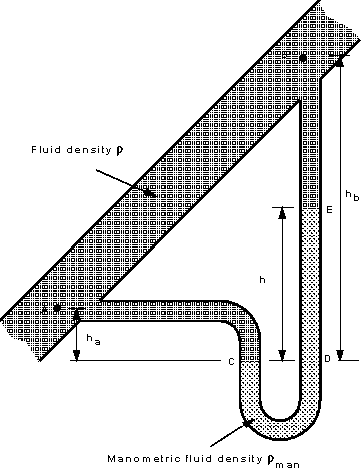
Pressure difference measurement by the "U"-Tube manometer
If the manometer is arranged as in the figure above, then
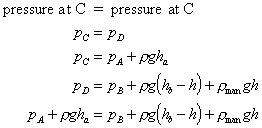
Giving the pressure difference

Again, if the fluid whose pressure difference is
being measured is a gas and  , then the
terms involving
, then the
terms involving  can be neglected, so
can be neglected, so

4. Advances to the "U" tube manometer.
The "U"-tube manometer has the disadvantage that the change in height of the liquid in both sides must be read. This can be avoided by making the diameter of one side very large compared to the other. In this case the side with the large area moves very little when the small area side move considerably more.
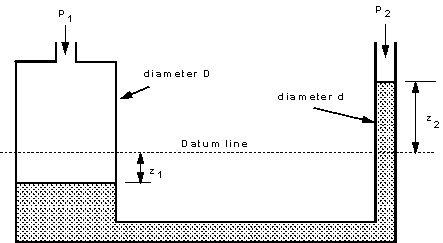
Assume the manometer is arranged as above to measure
the pressure difference of a gas of (negligible density) and that
pressure difference is  . If the datum
line indicates the level of the manometric fluid when the pressure
difference is zero and the height differences when pressure is
applied is as shown, the volume of liquid transferred from the
left side to the right
. If the datum
line indicates the level of the manometric fluid when the pressure
difference is zero and the height differences when pressure is
applied is as shown, the volume of liquid transferred from the
left side to the right 
And the fall in level of the left side is
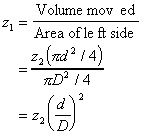
We know from the theory of the "U" tube manometer that the height different in the two columns gives the pressure difference so
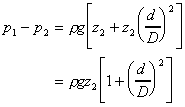
Clearly if D is very much larger than d then (d/D)2 is very small so

So only one reading need be taken to measure the pressure difference.
If the pressure to be measured is very small then tilting the arm provides a convenient way of obtaining a larger (more easily read) movement of the manometer. The above arrangement with a tilted arm is shown in the figure below.
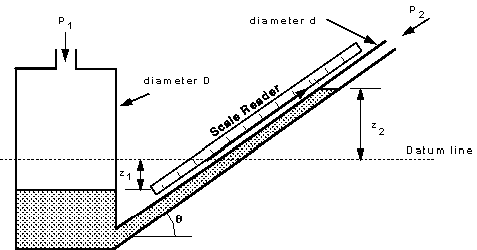
Tilted manometer.
The pressure difference is still given by the height change of the manometric fluid but by placing the scale along the line of the tilted arm and taking this reading large movements will be observed. The pressure difference is then given by

The sensitivity to pressure change can be increased further by a greater inclination of the manometer arm, alternatively the density of the manometric fluid may be changed.
5. Choice Of Manometer
Care must be taken when attaching the manometer to vessel, no burrs must be present around this joint. Burrs would alter the flow causing local pressure variations to affect the measurement.
Some disadvantages of manometers:
- Slow response - only really useful for very slowly varying pressures - no use at all for fluctuating pressures;
- For the "U" tube manometer two measurements must be taken simultaneously to get the h value. This may be avoided by using a tube with a much larger cross-sectional area on one side of the manometer than the other;
- It is often difficult to measure small variations in pressure - a different manometric fluid may be required - alternatively a sloping manometer may be employed; It cannot be used for very large pressures unless several manometers are connected in series;
- For very accurate work the temperature and relationship between temperature and r must be known;
Some advantages of manometers:
- They are very simple.
- No calibration is required - the pressure can be calculated from first principles.
